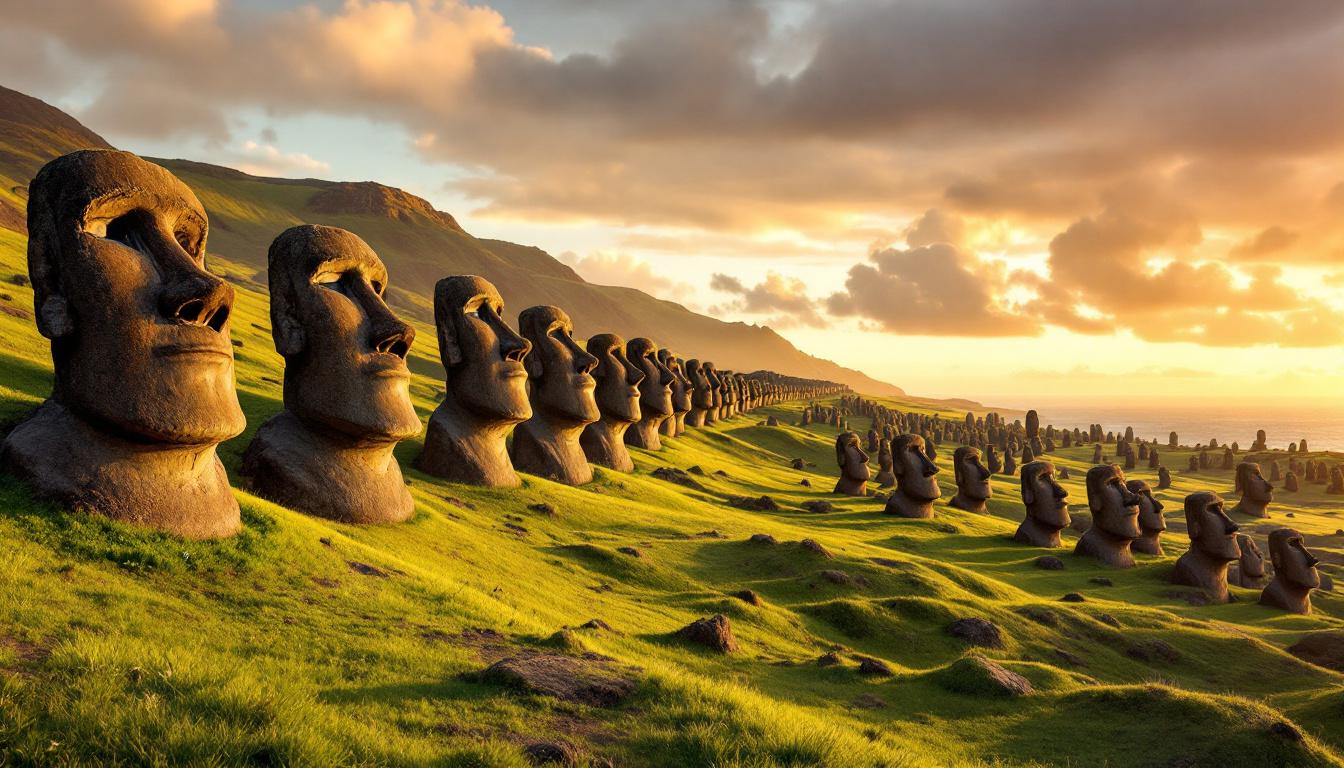While millions crowd into overpriced Tahitian resorts watching staged cultural shows, Easter Island protects nearly 900 ancient moai statues with zero cruise ships and living Rapa Nui culture that transforms every visitor. This remote Pacific sanctuary costs the same as Tahiti but delivers authentic archaeological wonders instead of commercialized paradise.
At 3,700 kilometers from mainland Chile, Easter Island receives just 30,000 annual visitors compared to Tahiti’s 236,000 crowds. No cruise ships dock here—only committed travelers willing to fly into one of the world’s most isolated airports discover what Polynesian culture looked like before mass tourism.
The numbers don’t lie: while Tahiti builds more luxury resorts for international corporations, Easter Island’s Rapa Nui National Park protects UNESCO World Heritage sites where local families still perform traditional ceremonies their ancestors created centuries ago.
Why Tahiti disappoints modern cultural travelers
Corporate tourism has replaced authentic Polynesian experiences
Tahiti’s tourism industry generates revenue for international hotel chains while local culture becomes background entertainment. 80% of visitors stay in foreign-owned resorts that package “cultural experiences” into sanitized performances, removing the spiritual depth that makes Polynesian traditions meaningful.
Cruise ship crowds destroy intimate island connections
Multiple cruise ships dock daily in Papeete, flooding cultural sites with thousands of passengers who spend mere hours before departing. This hit-and-run tourism prevents meaningful cultural exchange while overwhelming local infrastructure designed for smaller communities.
Easter Island’s archaeological treasures dwarf any Pacific alternative
Nearly 900 moai statues create the world’s most mysterious outdoor museum
Rano Raraku quarry alone contains 397 moai statues in various completion stages, offering insights into ancient Rapa Nui civilization impossible to find elsewhere. These aren’t replicas or tourist reconstructions—they’re original archaeological sites where families still leave offerings and perform traditional rituals.
UNESCO protection ensures authentic preservation over profit
Unlike Tahiti’s commercial development, Easter Island’s World Heritage status legally protects cultural sites from exploitation. Park fees support local Rapa Nui families who guide visitors through ancestral lands, sharing oral histories passed down through generations rather than rehearsed tourist scripts.
Living Rapa Nui culture offers transformation Tahiti cannot match
Community-owned tours connect visitors with authentic island life
Local operators like Cabalgatas Pantu and Rapa Nui families provide horseback tours to hidden moai sites while sharing traditional ecological knowledge. These aren’t staged performances—they’re genuine cultural exchanges where visitors learn sustainable practices Rapa Nui people developed over centuries.
Traditional ceremonies happen year-round, not just for tourists
The February Tapati Rapa Nui festival showcases competitions, dances, and rituals that locals practice throughout the year for cultural preservation, not tourist entertainment. Visitors witness authentic celebrations where community members compete in traditional skills their ancestors used for survival.
Practical advantages that make Easter Island the superior choice
Budget accommodation costs beat Tahitian luxury pricing
Easter Island offers comfortable stays for €35 per person daily excluding flights, while maintaining authentic local character. Compare this to Tahiti’s luxury resort rates that often exceed $300 nightly without delivering genuine cultural immersion or archaeological significance.
Limited access creates exclusive experiences worth the journey
LATAM operates just one daily flight from Santiago, with rare monthly connections from Papeete, ensuring only dedicated travelers reach the island. This accessibility challenge filters out casual tourists while rewarding committed visitors with intimate cultural encounters impossible in mass-tourism destinations.
Easter Island proves that authentic Polynesian culture still thrives when communities control their tourism narrative. While Tahiti caters to cruise ship schedules and corporate profits, Rapa Nui families protect ancestral lands where traditional Pacific island ceremonies maintain spiritual significance.
Book flights through Santiago rather than expensive Tahitian connections, and prepare for remote island adventures that transform understanding of Pacific heritage. Easter Island’s 900 moai statues and living Rapa Nui culture offer the authentic Polynesian experience that overcrowded tropical destinations can no longer provide.
Planning your authentic Easter Island experience
When should I visit Easter Island for the best cultural experience?
February offers the Tapati Rapa Nui festival with traditional competitions and ceremonies, while July through September provides cooler weather ideal for archaeological site exploration without summer crowds.
How do I respect Rapa Nui culture during my visit?
Book tours with local Rapa Nui guides, never touch moai statues, ask permission before photographing people, and support community-owned businesses rather than international chains to ensure tourism benefits local families.
What makes Easter Island more authentic than other Pacific islands?
Easter Island maintains UNESCO World Heritage protection, has zero cruise ship access, and keeps tourism numbers below 30,000 annually through limited flights, ensuring genuine cultural preservation over commercial exploitation.
